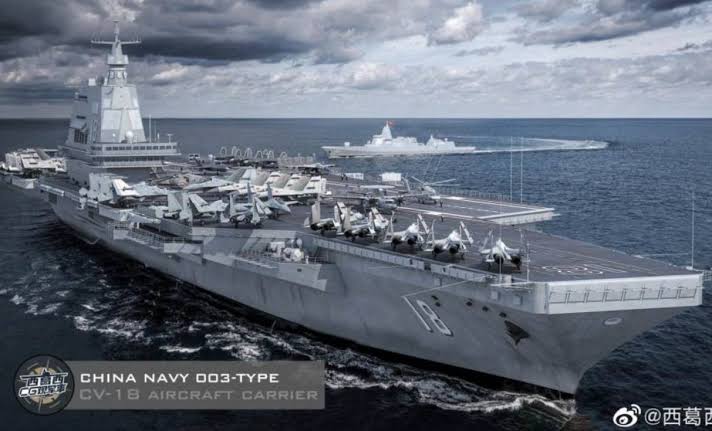Construction of China’s 3rd Aircraft Carrier Continues To Progress

Construction of China’s 3rd aircraft carrier Type 003 CV-18 continues to progress at Jiangnan Shipyard in Shanghai. The ship will be the largest surface warship that will enter into service with the Chinese Navy
The construction of the Type 003 aircraft carrier started in 2018, and satellite images published in 2020 have shown that prefabricated components of the vessel’s hull have been assembled. New pictures unveiled on May 30, 2021, showed that the flight deck is almost finished. The Type 003 could be commissioned as early as 2025.
By that time the Indian Navy will also have two aircraft carriers in service.
The Type 003 Chinese aircraft carrier Will be using a CATOBAR system and electromagnetic (EM) launch catapults. The CATOBAR is a system used for the launch and recovery of aircraft from the deck of an aircraft carrier. Under this technique, aircraft launch using a catapult-assisted take-off and land on the ship (the recovery phase) using arrestor wires.
The Type 003 will be longer than its predecessors, the Type 001 and Type 002, which each measure around 304 meters in length. The general layout of the Type 003 seems similar to the Nimitz-class aircraft carrier in service with the U.S. Navy. It will also be much wider to allow the transport of more planes.
China’s Type 003 carriers may have a displacement of 80,000 tons to 85,000 tons. A November 29, 2020, press report, however, states that satellite images of the first Type 003 carrier under construction suggest that this estimate may be a bit low and that the Type 003 carriers will be closer in displacement to U.S. Navy aircraft carriers, which have a displacement of about 100,000 tons.
China’s primary carrier-based fighter aircraft is the J-15 or Flying Shark, an aircraft derived from the Russian Su-33 Flanker aircraft design that can operate from carriers equipped with a ski ramp rather than catapults. China reportedly plans to develop a carrier-capable variant of its J-20 fifth-generation stealth fighter and/or a carrier-capable variant of its FC-31 fifth-generation stealth fighter to complement or succeed the J-15 on catapult-equipped Chinese carriers.
China reportedly is also developing a carrier-based airborne early warning (AEW) aircraft, called the KJ-600. This aircraft seems similar to the U.S. Navy’s carrier-based E-2 Hawkeye AEW aircraft. Citing military sources, the early warning aircraft equipped on the two Chinese aircraft carriers were all helicopters, and the radar detection range was limited, and the airborne time and range were limited. The KJ-600 fixed-wing carrier-based early warning aircraft has improved radar detection range and range, and its flight speed is also fast, so combat effectiveness will be greatly improved.
According to its size and load-displacement, the Type 003 will be able to carry about 60 carrier-based aircraft, and it can carry about 80 carrier-based aircraft in the extreme state.
By 2040 Chinese Navy plans to operate 10 aircraft carriers, a formidable force. To counter it successfully and keep it away from the Indian Ocean Region, Indian Navy needs to have six carrier battle groups operating in the Indian Navy. Therefore it is imperative that keel for a 65000 ton third aircraft Carrier be launched without much procrastination, otherwise it may be a bit too late.




